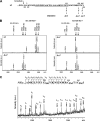S acylation of the hemagglutinin of influenza viruses: mass spectrometry reveals site-specific attachment of stearic acid to a transmembrane cysteine
- PMID: 18596092
- PMCID: PMC2546910
- DOI: 10.1128/JVI.00704-08
S acylation of the hemagglutinin of influenza viruses: mass spectrometry reveals site-specific attachment of stearic acid to a transmembrane cysteine
Abstract
S acylation of cysteines located in the transmembrane and/or cytoplasmic region of influenza virus hemagglutinins (HA) contributes to the membrane fusion and assembly of virions. Our results from using mass spectrometry (MS) show that influenza B virus HA possessing two cytoplasmic cysteines contains palmitate, whereas HA-esterase-fusion glycoprotein of influenza C virus having one transmembrane cysteine is stearoylated. HAs of influenza A virus having one transmembrane and two cytoplasmic cysteines contain both palmitate and stearate. MS analysis of recombinant viruses with deletions of individual cysteines, as well as tandem-MS sequencing, revealed the surprising result that stearate is exclusively attached to the cysteine positioned in the transmembrane region of HA.
Figures



References
-
- Kordyukova, L. V., A. L. Ksenofontov, M. V. Serebryakova, T. V. Ovchinnikova, N. V. Fedorova, V. T. Ivanova, and L. A. Baratova. 2004. Influenza A hemagglutinin C-terminal anchoring peptide: identification and mass spectrometric study. Protein Pept. Lett. 11385-391. - PubMed
-
- Linder, M. E., and R. J. Deschenes. 2007. Palmitoylation: policing protein stability and traffic. Nat. Rev. Mol. Cell Biol. 874-84. - PubMed
-
- Melkonian, K. A., A. G. Ostermeyer, J. Z. Chen, M. G. Roth, and D. A. Brown. 1999. Role of lipid modifications in targeting proteins to detergent-resistant membrane rafts. Many raft proteins are acylated, while few are prenylated. J. Biol. Chem. 2743910-3917. - PubMed
-
- Munro, S. 2003. Lipid rafts: elusive or illusive? Cell 115377-388. - PubMed
Publication types
MeSH terms
Substances
LinkOut - more resources
Full Text Sources

